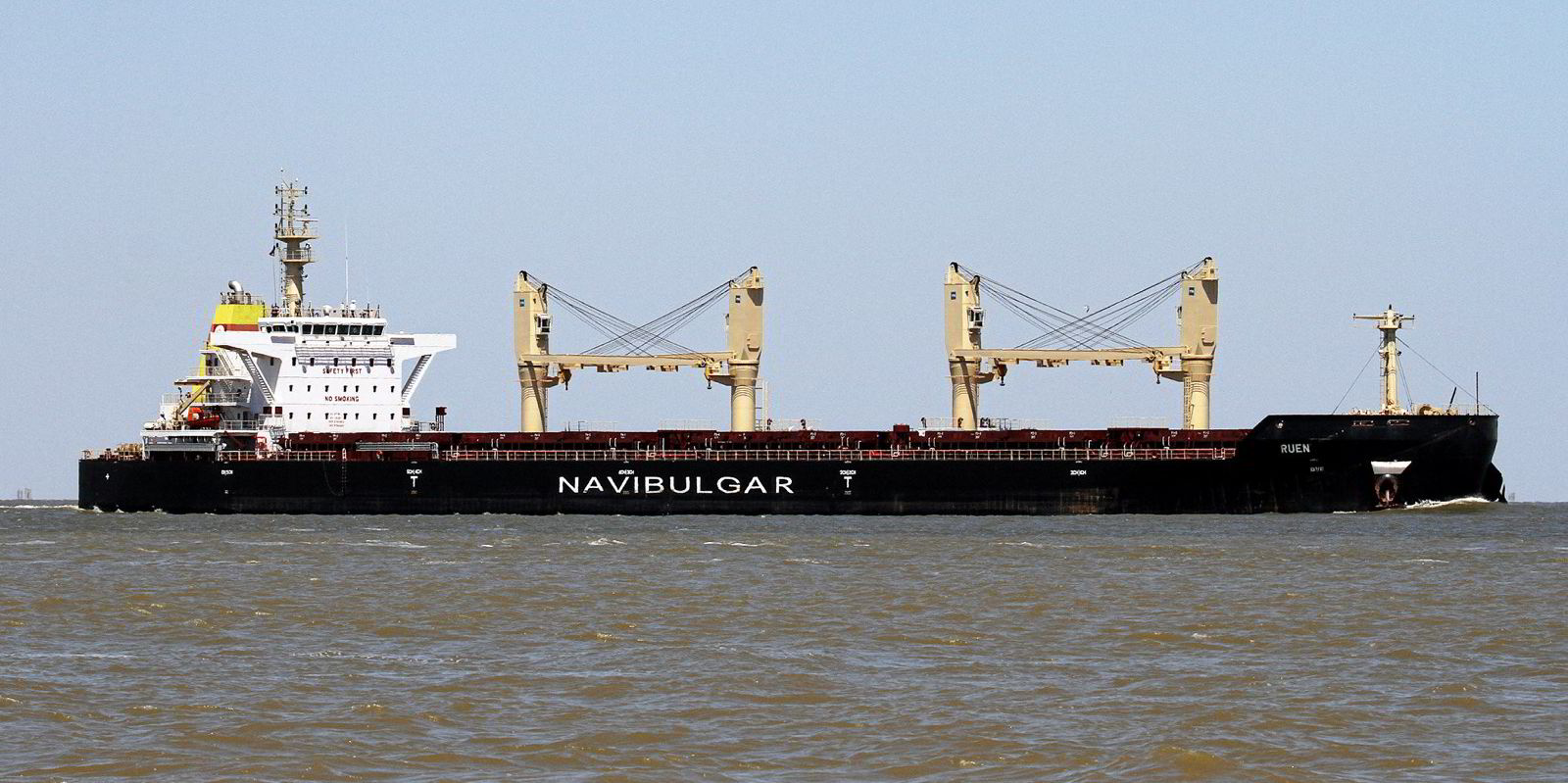Houthis struck a big Hapag-Lloyd container ship in the Red Sea on Friday, with the Yemen rebels attacking merchant vessels on an almost daily basis this week.
The German company confirmed that its 15,000-teu Al Jasrah (built 2016), a ship sailing in the company’s MD2 service, was attacked while sailing close to the coast of Yemen.
“No crew member was injured,” company spokesman Nils Haupt told TradeWinds.
“Hapag-Lloyd will take additional measures to secure the safety of our crews,” he added, declining to provide further details.
TradeWinds reported earlier on Friday, citing the United Kingdom Maritime Trade Authority (UKMTO), about an incident near the Bab al-Mandab Strait, about 50 nautical miles (93 km) north of Mokha, Yemen.
Maritime intelligence firm Diaplous subsequently said it had received reports of a Liberia-flagged container vessel getting hit on its portside by a missile or a drone.
An explosion is said to have occurred, causing a fire on deck and one container fell into the sea.
Another separate incident was reported about 60 nautical miles south-west of Hodeida, the UKMTO tweeted without giving further details.
TradeWinds is told that the Liberia-flagged 12,199-teu MSC Alanya (built 2021) was reported to have conducted evasive manoeuvres.
Operator MSC Mediterranean Shipping Company has been contacted for further information.
AIS data shows the container ship underway at 08.00 local time from Salalah in Oman to Jeddah in Saudi Arabia.
Houthis have been carrying out strikes against ships in this area for weeks, as part of their stated policy to target vessels they believe to be controlled by Israeli interests or calling at Israeli ports.
In a statement early on Friday, Houthi spokesman Yahya Saree claimed that the rebels’ forces “were successful in preventing the passage of multiple ships heading to the Israeli entity”.
He did not provide evidence to back up his claim. However, maritime sources have told TradeWinds that they have received anecdotal evidence of vessels being diverted from the region and charterparties for transits through the Red Sea including options for round-Africa trips.
19 November: The car carrier Galaxy Leader is hijacked in the Red Sea.
24 November: Drones attack the container ship CMA CGM Symi in the Indian Ocean.
26 November: The tanker Central Park was briefly boarded in the Gulf of Aden. Would-be hijackers were captured by the US Navy after attempting an escape. Ballistic missiles were fired at the ship and the USS Mason in response.
3 December: The Unity Explorer, container ship Number 9 and Sophie II were targeted in drone and missile attacks.
12 December: The J Ludwig Mowinckels Rederi-controlled Strinda was hit by an anti-ship missile in the Red Sea.
13 December: An attempted boarding of the tanker Ardmore Encounter was followed by a failed missile strike.
14 December: The Maersk Gibraltar was unsuccessfully targeted by an anti-ship missile. A Navibulgar bulker is boarded in the Gulf of Aden.
Israeli-owned ships are known to have been rerouting since mid-November when the Houthis began targeting them.
In the latest confirmed Houthi attack on Thursday, a missile just missed the AP Moller-Maersk-operated 10,100-teu container ship Maersk Gibraltar (built 2016) near the Hanish islands off south-west Yemen.
In his statement on Friday, Saree claimed that the hit against the AP Moller-Maersk ship was “accurate”. However, the Danish liner giant reaffirmed that the Maersk Gibraltar was not hit.
What happened to the Ruen?
Meanwhile, a Bulgarian bulker that was reported as having been boarded by unknown assailants in the open Arabian Sea on Thursday is still drifting in the area.
The 41,600-dwt Ruen (built 2016) was previously observed moving erratically at increasing and decreasing speeds, likely in evasive manoeuvres.
Navibulgar, the vessel’s owner, has not responded to a request for comment.
In its latest update early on Friday, the UKMTO said it had received a report from authorities that the boarded vessel, which it did not identify, was adrift about 700 nautical miles east of Bosaso, Somalia, or about 400 nautical miles east of Yemen’s Socotra Island.
Ambrey Analytics said all 18 crew were safe in the ship’s citadel, with surveillance and response operations ongoing.
The Malta-flagged Ruen does not appear to have sailed to Israel recently.
However, another Navibulgar handysize with a similar name — the 44,900-dwt Rojen (built 2019) — was in Ashdod when the Hamas-Israel war broke out in October.
The Houthi escalation goes hand-in-hand with numerous reports from ship masters of suspicious activity by small craft at the entrance to the Red Sea.
The US military attributed the attack and brief boarding on 26 November of Zodiac Maritime’s 20,000-dwt tanker Central Park (built 2015) to piracy, most probably by Somali nationals.
Houthi threat no longer ‘transit-specific’
Ambrey Analytics said it is likely that the Houthis may target vessels whose parent companies have cooperated with Israel.
“This means the threat is no longer transit-specific, linked to a particular vessel and its port calls,” the security company said.
“As some affiliated merchant shipping diverts from the area, the Houthis are assessed to maintain their broadened scope of potential targets. The insurance industry has responded with markedly higher rates across the board,” Ambrey said.
The company believes that, despite the stated intent to disrupt Israeli commercial trade, the risk of collateral damage from debris among the wider shipping community persists in the region.
“There has been an increased military presence in the Red Sea, which has led to the interception of many missiles and UAVs, but the presence has been uneven, meaning ship hardening and protection measures remain important to mitigate the associated risks of transiting the area,” Ambrey advised.





